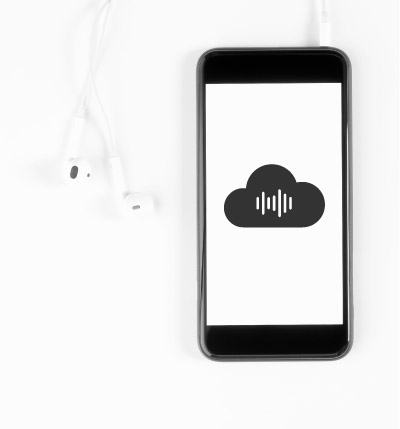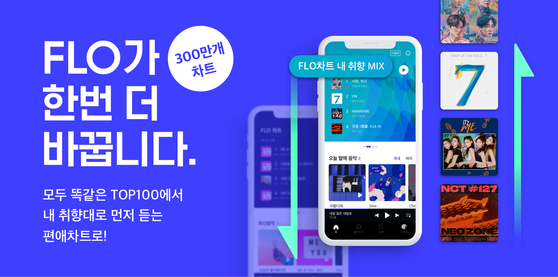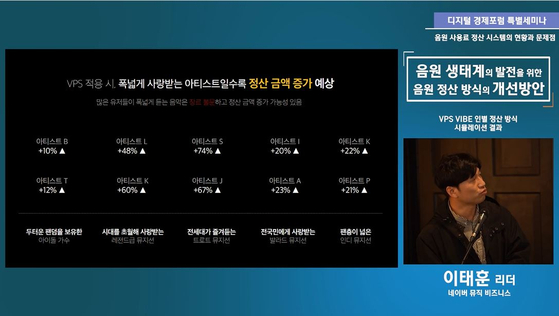Music services rush to adapt to keep customers

As Spotify prepares its Korea launch, local players change
As global music provider Spotify readies its official launch into the Korean market and consumers become more open to using new services, local companies are looking to meet the needs of the new era, mainly by changing the way they distribute their income with artists or coming up with new ways to curate music for each user.
According to market researcher Nielsen Koreanclick, the number of monthly active users of Kakao’s Melon — the No. 1 streaming service in Korea — has been declining since September last year when its market share fell below the 40 percent mark for the first time. The company hit a low of 36.8 percent in March.
KT’s Genie Music’s market share fell by 0.9 percent from February to March, when it recorded 24.8 percent, and SKT’s Flo fell by 0.4 percent compared to February, hitting 17.3 percent.
In contrast, Google’s YouTube Music jumped 2.7 percent from 6.3 percent in February to 9 percent in March — its total number of users increased by 54 percent from 990,000 users to 1.53 million.
![Spotify opened a Korean office in January and is preparing to make its official launch soon. [SPOTIFY]](https://koreajoongangdaily.joins.com/data/photo/2020/05/07/a7cfca18-6b06-4f1c-a894-608988173cd9.jpg)
Spotify opened a Korean office in January and is preparing to make its official launch soon. [SPOTIFY]
Spotify may be the biggest threat that local streaming services have ever faced. The major global player began in 2008 in Sweden and soon expanded into 79 countries, including the United States, France and Japan. As of 2019, the service had as many as 271 million users — an intimidating number to Korean competitors whose main focus is on local users. Half of Spotify’s users pay for a subscription to the service, while the other half has to listen to advertisements to cover the copyright fees paid to artists and labels.
Another threat that Spotify poses also comes from the vast number of users to its service, specifically on the data that Spotify gathers from each user. The big data it accumulates is analyzed by artificial intelligence technology — conjuring up personalized recommendation lists each week.
The Discover Weekly is the most popular feature developed from this technology. Every Monday, Spotify recommends a tailored playlist filled with music the user has never listened to before based on music they have already listened to. It takes up 17 percent of all streaming time from users.
And while local services dominate the market for now, the rising popularity of K-pop internationally has Spotify’s eyes on Korea: K-pop songs were played for 134 billion minutes from January last year to January this year, mainly led by the global players like BTS and Blackpink.
In fact, Spotify opened up its Spotify Korea office in the bustling southern Seoul neighborhood of Gangnam in January, and it is being led by Peter Grandelius, head of corporate legal at Spotify. The exact date of when it will open its Korean service was initially said to be in June, but the coronavirus has put everything up in the air.
The strategies local streaming services are arming themselves with are not much different than Spotify’s existing offerings. Many local companies believe that only by abandoning their dependence on the Now Hot charts can they escape the chart manipulation controversies. Instead, they are focusing on launching products like customized playlists and more.

Flo provides a chart tailored to each listener.
Naver’s Vibe, which shut down the Now Hot chart in January last year, announced that it will soon launch its new Vibe Payment System (VPS) by the first half of this year. Naver signed rapper Mommy Son to be the official spokesperson of the system and is actively promoting it. Right now, Vibe shares all payments from users and divides it according to how many times a song is played. It then allocates the share to the copyright holders.

Naver’s Vibe will soon launch a new distribution system VPS.
Lee Tae-hoon, the leader of Naver’s music business, recently attended a seminar hosted by the Digital Economy Forum regarding the methods music services can use to improve their profit distribution systems to better the music market. There, he spoke about the results of a simulation of VPS. Supposing that User A and User B both pay 10,000 won ($8) a month and User A listens to Singer C’s song 10 times a month while User B listens to Singer D’s song 90 times a month, Singer C will get 10 percent of 20,000 won — the total payment paid by the two users — and Singer D will get 18,000 won. But without VPS, both singers would get 10,000 won.
“With the new system, songs that are listened to by the majority of users get more shares of the money, while songs listened by the minority of users get less,” he said.
Yet, it remains to be seen whether this method will be welcomed by everyone, because it means that the more songs are listened to, the unit cost of the song becomes smaller, and the less that songs are listened to, the unit cost of the song becomes higher. For a user who listens to 10 songs and pays 10,000 won a month, they end up paying 1,000 won for each song. For someone who listens to 1,000 songs a month, each song ends up costing 10 won.

A seminar hosted by the Digital Economy Forum regarding the methods music services can use to improve their profit distribution systems to better the music market
“This could be a solution to the chart manipulation issue, but it won’t be a fundamental cure for the core problem,” said Yoo Jae-jin, chief of the management support team at the Recording Industry Association of Korea.
Kim Jin-woo, head researcher at Gaon Chart and a music data journalist, pointed out that the leaders of the market need to step up to tackle the problem because it is hard to change people’s consumption patterns in a short time.
“Samsung Music abandoned the Now Hot chart in the past and began a personalized curated chart system, and Apple Music launched in Korea in 2016 — but the two still struggle in the market,” Kim said.
He said that this is the perfect time to implement a new system. Pop music from abroad took up 6.2 percent of the songs in the Top 400 chart in 2009 but has risen to 23.9 percent in 2018, proving that local listeners have become more open to music from around the world.
Since the general public has become suspicious of the big-name local music streaming services recently due to the chart manipulation controversies, it has never been a better time for a new name to enter the ring.
“The history of Korean music is much shorter than that of pop music around the world ... so it might be hard to get a precise outcome from digital algorithms,” Kim said. “The game changer will be how many Korean songs the global services have and also if they can provide a localized service for Korean listeners.”
BY MIN KYUNG-WON [yoon.soyeon@joongang.co.kr]
실시간차트 없애고, 들은 만큼 내고…음원 사재기 사라질까
국내 음원 유통 시장의 변화가 곳곳에서 감지되고 있다. 글로벌 최대 음악 플랫폼인 스포티파이가 올해 한국 시장 진출을 앞둔 상황에서 SKT 플로는 실시간 음원 차트 폐지, 네이버 바이브는 음원 수익 배분 방식 변경 등 새로운 실험에 나선 것. 통신사와 연결된 음원 서비스를 이용해온 보수적인 소비자들도 유튜브 뮤직 등 신규 플랫폼으로 옮겨가면서 판도가 바뀌고 있는 상황이다.
시장조사업체 코리안클릭에 따르면 3월 월간 순 이용자(MAU) 기준 1위 사업자인 카카오 멜론의 점유율은 36.8%로 떨어졌다. 지난해 9월 40% 선이 무너진 이후 지속적인 하락세를 보이고 있는 것이다. 2위 KT 지니뮤직과 3위 플로 역시 각각 전달 대비 0.9%와 0.4%씩 감소해 24.8%, 17.3%의 점유율을 보였다. 반면 4위 구글 유튜브 뮤직는 6.3%에서 9.0%로 2.7%가량 증가했다. 이용자 수로 보면 약 99만명에서 153만명으로 54%나 늘어난 셈이다.
한국 업체들이 스포티파이를 견제하는 가장 큰 이유는 압도적인 규모다. 2008년 스웨덴에서 시작해 미국ㆍ프랑스ㆍ일본 등 79개국에서 서비스 중으로 지난해 말 기준 순 이용자만 2억7100만명에 달한다. 월 9.9달러(약 1만2000원)를 내고 이용하는 유료 회원은 1억2400만명으로 절반 수준이지만 문제 될 건 없다. 광고 청취를 통해 이용자는 무료로 음악을 듣고, 창작자에게는 저작권료를 지급해 쌍방이 원하는 바를 얻을 수 있는 구조다.
이렇게 모인 빅데이터와 인공지능(AI) 기술을 결합한 큐레이션 시스템도 강점이다. 구독 기반의 온라인 동영상 플랫폼 넷플릭스처럼 이용자의 취향에 맞는 음악을 추천해준다. 매주 월요일마다 이용자가 한 번도 듣지 않았지만 좋아할 확률이 높은 곡을 골라 1 : 1 맞춤 플레이리스트를 제공하는 ‘디스커버 위클리’가 특히 반응이 좋다. 스포티파이 내 소비 시간 중 17%에 달할 정도로 취향 적중 확률이 높다.
스포티파이도 한국 시장에 오랫동안 공을 들여왔다. 방탄소년단ㆍ블랙핑크 등 K팝 팬덤이 전 세계로 확산되면서 지난해 1월부터 올 1월까지 K팝 음악이 1340억분 이상 재생되는 등 환영받고 있기 때문이다. 지난 1월 서울 강남에 스포티파이 코리아를 설립하고, 본사 법무 총괄인 피터 그란델리우스가 한국 법인 대표를 맡는 등 열의를 보이고 있다. 올 6월 서비스 론칭이 목표였으나 신종 코로나바이러스 감염증(코로나19) 여파로 다소 늦춰질 가능성도 있다.
국내 음원 서비스가 추구하는 변화 역시 방향성은 비슷하다. 궁극적으로는 실시간 음원 차트를 폐지하고, 개인화된 서비스를 제공할 수 있어야 사재기 논란에서 벗어날 수 있을뿐더러 업체별로 특색있는 상품을 선보일 수 있기 때문이다. 이를 위해 플로는 지난 3월 19일부터 1시간 단위로 집계되는 실시간 순위를 폐지하고 24시간 누적 순위만 발표하고 있다. 1달여간 시행 결과 3일 기준 조정석의 ‘아로하’, 오마이걸의 ‘살짝 설렜어’ 등 1, 2위 순위는 크게 다르지 않지만 아이돌 그룹이 새 앨범을 발표할 때마다 등장하는 수록곡 줄 세우기 같은 현상은 사라졌다.
플로는 이에 그치지 않고 이달 초 ‘편애차트’ 도입 계획을 밝혔다. ‘톱 100’ 차트 이용 패턴을 분석한 결과 상위 3곡만 이용하는 사람이 절반에 달하는 것에 착안해 해당 이용자의 재생 이력 및 선호를 반영, 개인 취향 기반으로 재정렬한 맞춤형 차트를 선보이겠다는 계획이다.
지난해 1월 실시간 차트를 없앤 바이브는 한발 더 나아가 올 상반기 중 새로운 정산방식인 ‘바이브 페이먼트 시스템(VPS)’을 도입하겠다고 밝혔다. 현재는 소비자들이 낸 전체 음원 이용료에서 재생 횟수 비중에 따라 수익을 가수ㆍ작곡가 등 저작권자에게 나눠주는 ‘비례배분제’를 채택하고 있지만, 내 돈은 내가 듣는 음악, 내가 좋아하는 가수에게 가는 이른바 ‘내돈내듣’(인별 정산) 방식으로 개편하겠다는 취지다. 래퍼 마미손을 모델로 내세워 관련 캠페인을 벌이는 등 홍보에도 적극적이다.
네이버 뮤직비즈니스를 담당하는 이태훈 리더는 지난달 21일 ‘음원 생태계 발전을 위한 음원 정산 방식 개선 방안’ 세미나에 참석해 시뮬레이션 결과를 공개했다. 예를 들어 A와 B가 각 1만원씩 이용료를 내고 A는 가수 C의 노래를 10번, B는 가수 D의 노래를 90번 듣는다고 가정하면, C는 전체 이용료 2만원의 10%인 2000원을 받는 반면 D는 90%인 1만8000원을 받게 된다. 하지만 바이브 방식을 적용할 경우 각각 1만원씩 받게 된다. 그는 “새로운 방식을 적용해본 결과 다수 이용자가 많이 듣는 음악은 정산 금액이 증가하고, 소수 이용자가 많이 듣는 음악은 정산 금액이 줄어든다”고 설명했다.
하지만 이 같은 방식이 모두에게 환영받을지는 아직 미지수다. 음악을 적게 들을수록 곡당 단가가 커지고, 많이 들을수록 단가가 낮아지기 때문이다. 1달에 1만원을 내고 10번 듣는 이용자에게는 곡당 1000원이지만, 1000번 듣는 사람에게는 곡당 10원인 셈이다. 한국음반산업협회 유재진 국장은 “음원 사재기 등의 문제를 해결하는 데 도움이 될 순 있지만 근본적인 해결 방안은 아니다”라고 지적했다. 두 방식 모두 정액요금제 내에서 비율 배분으로 창작자의 권리를 온전하게 인정받는 것은 아니라는 취지에서다.
실질적인 변화를 끌어내기 위해서는 1ㆍ2위 사업자가 나서야 한다는 지적도 있다. 가온차트 김진우 수석연구위원은 “과거 삼성뮤직도 실시간 차트를 없애고 큐레이션 서비스를 앞세웠고, 글로벌 2위 업체인 애플뮤직도 2016년 한국 시장에 진출했지만 아직 고전하고 있다”고 분석했다. 소비자의 이용 패턴이 한순간에 바뀌긴 힘들단 얘기다.
하지만 새 시스템을 도입하기에 시기적으로는 매우 적절하다고 판단했다. 연간차트 400위 내 팝의 비중이 2009년 6.2%에서 2018년 23.9%로 오르는 등 팝에 대한 수요가 지속적으로 늘어나고 있기 때문이다. 대형 음원사이트가 사재기 문제를 방관하고 있다는 여론도 신규 사업자에게 유리하다. 그는 “한국 음악은 팝과 비교하면 역사가 짧고 장르가 편중돼 있어 알고리즘을 적용해도 그에 맞는 결과값이 나오기 어려울 수도 있다”며 “한국 곡을 얼마나 확보하고 현지화된 서비스를 제공할 수 있을지가 관건이 될 것으로 보인다”고 덧붙였다.
민경원 기자










with the Korea JoongAng Daily
To write comments, please log in to one of the accounts.
Standards Board Policy (0/250자)